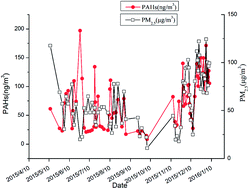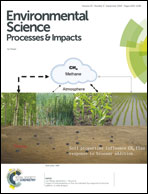PAHs in fine particles over Xi'an, a typical northwestern city in China: sources, distribution, and controlling factors†
Abstract
Levels of particle-bound polycyclic aromatic hydrocarbons (PAHs) are affected by emission as well as multiple factors. In this study, we investigated the sources, uptake, affinity, and removal mechanism of PAHs in fine particles (PM2.5). The source strength was analyzed with source apportionment, which was conducted by principal component analysis (PCA), positive matrix factorization (PMF) and diagnostic ratio analysis. The octanol–air and soot–air partitioning model was used to elucidate the partitioning behavior of PM2.5 PAHs. And the chemical reactivity of PM2.5 PAHs was analyzed to explain PAH removal from particles. Coal combustion, biomass burning, and vehicle emissions comprised the major sources of PAHs. The process of partitioning was thermally controlled and component-dependent. Heterogeneous reactions with NO2, OH, and O3, as well as the aqueous reaction, effectively reduced PM2.5 PAH levels. The systematic analysis combined with field observations revealed that the emission strength is the dominant factor controlling PM2.5 PAH distribution. The source strength governed the levels of PM2.5 PAHs, though uptake, partitioning behavior, chemical removal kinetics, and peripheral conditions had a non-ignorable impact. Heterogeneous and aqueous reactions were the dominant mechanisms of PAH removal from particles. This research provides a comprehensive insight into controlling factors on PM2.5 PAH distribution in Xi'an, as well as a theoretical basis for critical steps to control PAH levels.



 Please wait while we load your content...
Please wait while we load your content...